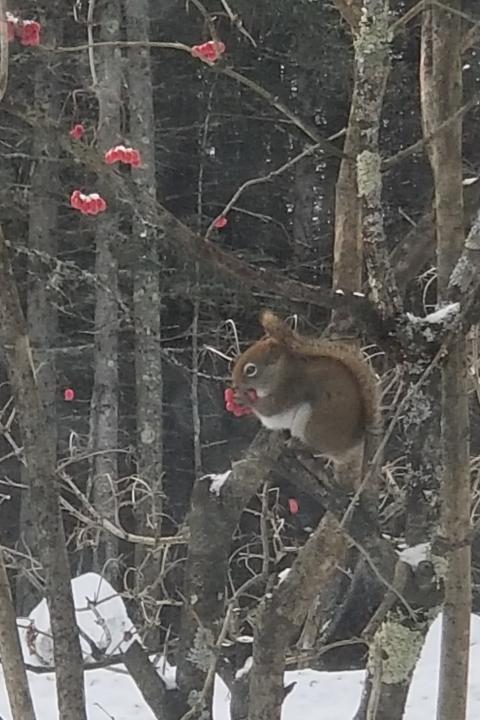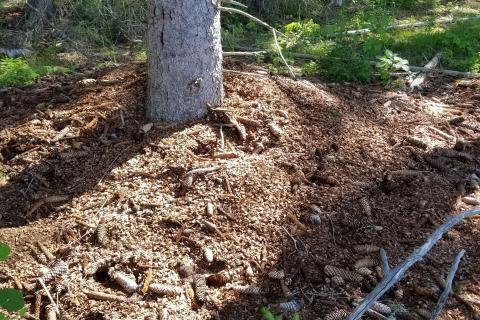Looking for Red Squirrels

When I walk in the woods, I usually don’t have to look for red squirrels if I’m in a spruce-fir dominated forest. They usually find me, especially if I’m trying to go unnoticed, like when I’m deer hunting. Invariably they locate me in my stand even though I’m sitting still and wearing camouflage clothing. Seeing me, they sit on a perch and scold relentlessly. They seem to get so worked up that they’re hyperventilating and close to a heart attack. I wonder if a squirrel has ever died that way.
The red squirrel ---Tamiasciurus hudsonicus---- is a member of a loose group known as tree squirrels which includes gray squirrels, fox squirrels, and flying squirrels. It is a ubiquitous resident of northern conifer forests. More specifically, the red squirrel is in the pine squirrel family, which also includes the Douglas squirrel and the southwestern red squirrel, both of which are found in the western US.
Habitat and Range
The American red squirrel is found across the North American continent where northern conifer forests are found. From Alaska to north of Georgia. The conifer and mixed conifer forests of northern New England are well-populated by red squirrels.
Habitat for red squirrels is found in middle age to old conifer dominated forests, particularly spruce-fir. Managing mature spruce-fir and mixed stands for deer wintering habitat or large diameter sawtimber should provide plenty of food and cover for red squirrels.
Description
The red squirrel is about half the size of its gray cousin, with a smaller tail. The fur, as the name implies, is generally reddish in color on most of the body but can have some gray hues as well. The abdomen is white, and a distinct white ring surrounds the dark eye.
Like all rodents, red squirrels’ front teeth continue growing throughout their lives and the animal needs to chew to keep the growth under control. Red squirrels are known to chew on wood, insulation, wiring, and other items in a home, creating damage and potential fire hazards.

Diet
Red squirrels feed on conifer seeds such as red and white spruce, balsam fir, hemlock, and white pine. It is common to see a stump or log covered with a pile of cone scales where squirrels have fed. Squirrels will use the same spot over and over, resulting in a large pile of cone pieces. These piles are called middens. The squirrels likely miss a few seeds, which may then have a chance to germinate. (Sometimes the middens dry out, so the seeds might not become seedlings.) Red squirrels also hide seeds for winter which may germinate the following spring if forgotten.
In addition to conifer seeds, red squirrels eat other nuts including acorns and beechnuts as well as fruits. Red squirrels, however, aren’t simply herbivores. I was surprised to find out that red squirrels are a major predator of songbird nests, eating both eggs and young birds when they have a chance.
A Prey Species
Red squirrels, like most rodents, are prey animals. Hawks, owls, fox, coyote, bobcat, weasels, fisher, and pine marten all eat red squirrels. In northern conifer forests the pine marten is an especially keen predator of red squirrels. Pine marten are excellent climbers and just as at home in the trees as their prey.
Hunters tend not to pursue red squirrels for meat, preferring the larger gray squirrel. Red squirrel meat isn’t known to be good eating. Something that eats pine and spruce cones as a mainstay of its diet isn’t going to taste as good as something that feeds regularly on acorns and beech nuts.
Though they can be annoying and cause damage, red squirrels are enjoyable to watch and play an important role in our conifer forests by spreading tree seeds and providing a ready food source for predators.
Have a question about your woods? Contact your Extension County Forester today!
Do you love learning about stuff like this? Subscribe to the NH Woods & Wildlife Newsletter.
A quarterly newsletter providing private woodlot owners in New Hampshire with woodlot management news, pest updates, resources, and more.
